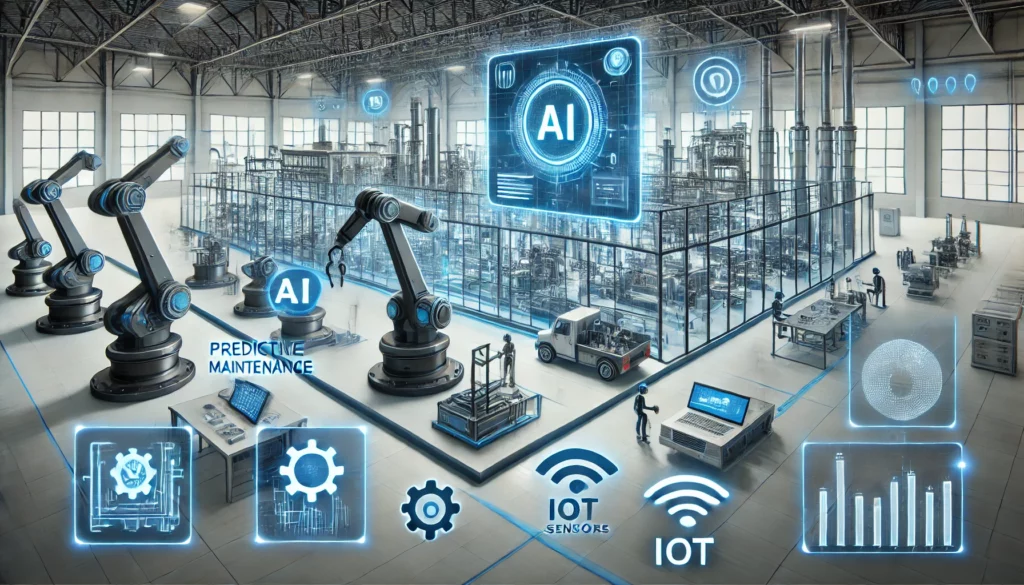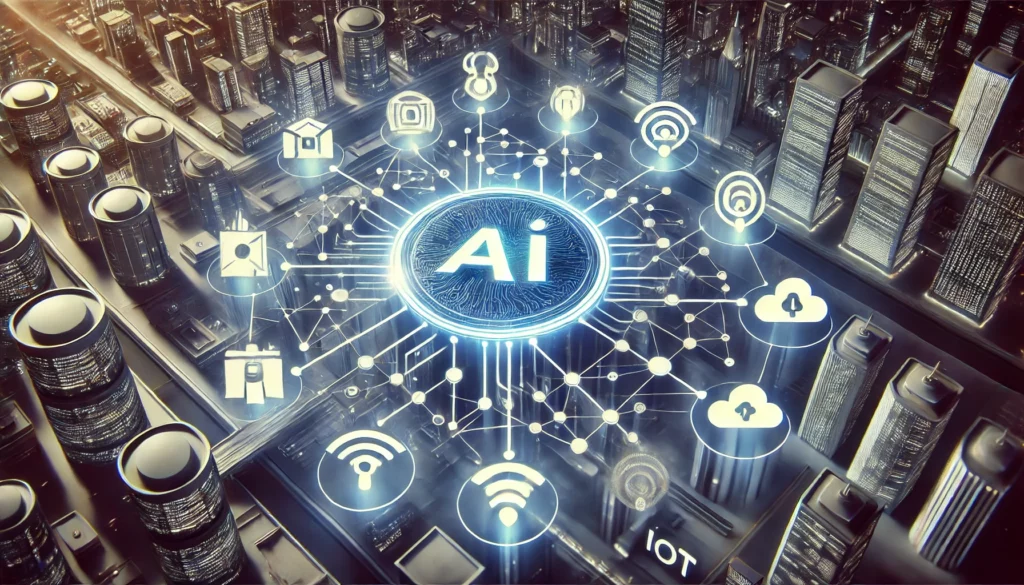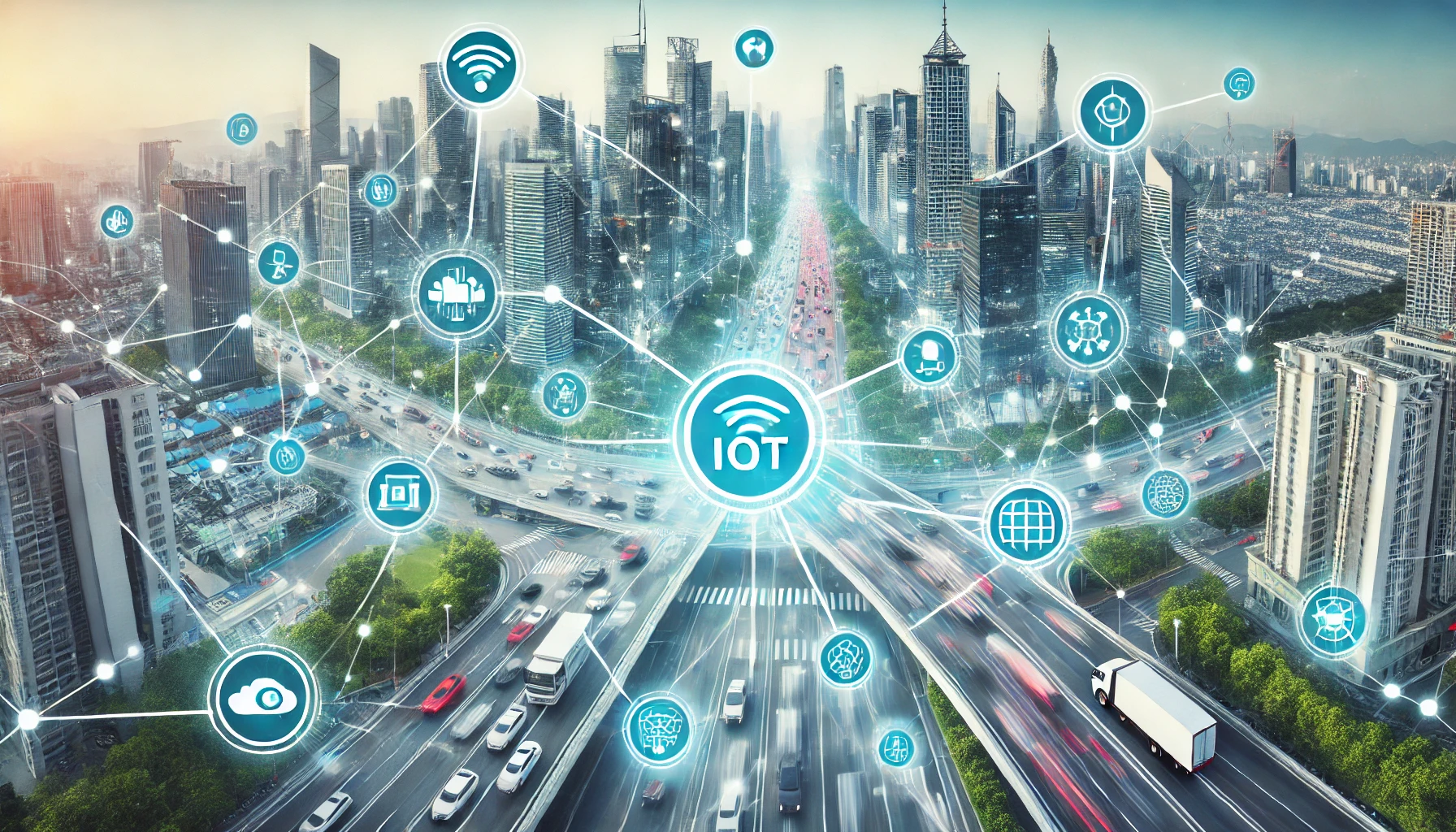Introduction
In the ever-evolving landscape of technology, the convergence of Artificial Intelligence (AI) and the Internet of Things (IoT) is creating a new paradigm known as AIoT. This powerful synergy is transforming various sectors by enabling smarter, more efficient, and adaptive systems. AI brings intelligence to IoT devices, allowing them to analyze data, learn from it, and make informed decisions autonomously. From enhancing healthcare and industrial automation to revolutionizing smart cities and personalized user experiences, AIoT is reshaping our world in unprecedented ways.
This article delves into the core concepts of AI and IoT, explores their key applications, highlights the benefits and challenges of their integration, and provides a glimpse into the future trends of AIoT. Join us as we uncover how AIoT is setting the stage for a smarter, more connected world.
Section 1: Understanding AI and IoT
- Definition and Basics of IoT
- What is IoT? IoT refers to the network of physical objects embedded with sensors, software, and other technologies to connect and exchange data with other devices and systems over the internet. These devices range from ordinary household objects to sophisticated industrial toolsThis interconnected web of devices enables efficient data collection, analysis, and automation, revolutionizing various industries such as manufacturing, healthcare, transportation, and agriculture. By leveraging IoT technology, businesses can streamline operations, enhance decision-making processes, and improve overall performance. Additionally, IoT plays a pivotal role in enabling the development of smart cities and enhancing the quality of life for individuals through connected services and infrastructure. As IoT continues to advance, its potential to drive innovation and create new possibilities remains boundless. (Total Phase) (Simform).
- Components and Functionality IoT devices collect data from their environment, transmit it to a centralized server or cloud platform, where it is processed and analyzed to provide valuable insightsThis data-driven approach allows for real-time monitoring and control of various systems, enabling efficient decision-making and optimization of processes. By leveraging the power of IoT technologies, businesses can enhance productivity, improve resource management, and deliver enhanced experiences to their customers. As the IoT ecosystem continues to evolve, the possibilities for innovation and transformation across industries are virtually limitless. (Total Phase).
- Definition and Basics of AI
- What is AI? AI is the simulation of human intelligence processes by machines, especially computer systems. These processes include learning (acquiring information and rules for using the information), reasoning (using rules to reach approximate or definite conclusions), and self-correctionIt is through these capabilities that AI systems can perform tasks that typically require human intelligence, such as visual perception, speech recognition, decision-making, and language translation. By leveraging algorithms and vast amounts of data, AI can analyze complex patterns, make predictions, and continuously improve its performance over time. As AI technology continues to advance, its potential to revolutionize industries, improve efficiency, and enhance our daily lives becomes increasingly apparent. (Simform) (LaPraim).
- Capabilities of AI AI enables machines to learn from experience, adjust to new inputs, and perform human-like tasks. This involves various technologies like machine learning, natural language processing, and roboticsThis integration of AI technologies allows machines to analyze data, recognize patterns, and make decisions with minimal human intervention. Through continuous improvement and adaptation, AI systems can enhance efficiency, accuracy, and innovation across industries. By harnessing the power of AI, organizations can unlock new opportunities for growth and progress in the ever-evolving landscape of technology and automation. (Total Phase).
- Convergence of AI and IoT (AIoT)
- AIoT Explained AIoT is the integration of AI with IoT devices, where AI enhances the capabilities of IoT by providing the intelligence needed to process and analyze the vast amounts of data generated by IoT devices. This integration leads to more efficient operations, improved user interactions, and smarter decision-makingFurthermore, AIoT enables predictive maintenance, real-time monitoring, and autonomous decision-making in various industries such as healthcare, manufacturing, and transportation. By harnessing the power of AI in conjunction with IoT devices, organizations can optimize processes, reduce costs, and deliver innovative solutions that drive digital transformation. As the capabilities of AI and IoT continue to advance, the potential for revolutionary developments in technology and business operations is limitless. (Simform) (DevOps School).
Section 2: Key Applications of AIoT
Healthcare
- Remote Health Monitoring and Telemedicine
- Application: Wearable devices equipped with sensors collect real-time health data such as heart rate, blood pressure, and glucose levels. AI analyzes this data to provide health insights and early warning signs for conditions like arrhythmias or glucose imbalances. This integration of wearable technology and AI has revolutionized healthcare monitoring, allowing individuals to track their health proactively and receive personalized recommendations for maintaining well-being. By continuously monitoring vital signs and patterns, these devices offer a comprehensive approach to preventive healthcare, empowering users to make informed decisions about their lifestyle and health management. As this technology continues to advance, the potential for early detection and intervention in health issues is becoming increasingly promising, ultimately leading to improved quality of life for many individuals. (Binariks) (IoT Business News).
- Example: Devices like Fitbit and Dexcom G6 offer continuous monitoring and AI-driven analysis to alert users and healthcare providers of potential health issues (Binariks).
- AI-Enabled Diagnostics
- Application: AI algorithms process imaging and other diagnostic data to detect anomalies and diseases at an early stage. This improves the accuracy and speed of diagnosticsThe use of AI algorithms in healthcare also aids in reducing human error in the interpretation of medical images, leading to more precise and reliable diagnoses. By leveraging machine learning and pattern recognition, these technologies can analyze vast amounts of data quickly, providing healthcare professionals with valuable insights to guide treatment decisions and improve patient outcomes. Additionally, early detection through AI-powered diagnostics can significantly increase the chances of successful treatment and ultimately save lives. (Binariks) (DevOps School).
- Example: Zebra Medical Vision uses AI to analyze medical images, helping radiologists identify conditions such as cancer more accurately (Binariks).
Industrial Automation

- Predictive Maintenance
- Application: IoT sensors monitor machinery and equipment, collecting data on performance, wear, and environmental conditions. AI analyzes this data to predict when maintenance is needed, preventing unexpected failures and reducing downtimeThis predictive maintenance approach not only enhances operational efficiency but also saves costs by addressing issues before they escalate. By leveraging the synergy between IoT sensors and AI algorithms, businesses can streamline their maintenance processes and ensure optimal performance of their assets. (IoT Business News) (Total Phase).
- Example: Siemens’ MindSphere platform uses AI to predict maintenance needs, optimizing production schedules and minimizing disruptions (Binariks).
- Optimizing Production
- Application: AI algorithms analyze data from IoT devices to optimize manufacturing processes, improve quality control, and reduce waste. This leads to more efficient and cost-effective operationsAs a result, companies can make data-driven decisions in real time, minimizing downtime and maximizing productivity. Furthermore, predictive maintenance algorithms help identify potential equipment failures before they occur, further increasing operational efficiency and minimizing disruptions in the manufacturing process. (IoT Business News) (Total Phase).
- Example: In a smart factory, AI can adjust production lines in real-time based on data from IoT sensors, ensuring optimal performance (IoT Business News).
Smart Cities
- Traffic Management
- Application: IoT sensors collect data on traffic flow and congestion. AI processes this data to optimize traffic light timings, reducing congestion and improving traffic flowBy analyzing patterns in traffic movement, AI algorithms can dynamically adjust traffic light timings in real-time. This proactive approach minimizes delays, enhances overall road safety, and contributes to a more efficient urban transportation system. (IoT Business News) (Total Phase).
- Example: Los Angeles uses an AI-driven traffic management system to adjust signal timings based on real-time data, reducing travel times and emissions (IoT Business News).
- Environmental Monitoring
- Application: Sensors monitor air quality, noise levels, and other environmental factors. AI analyzes this data to manage pollution and improve urban living conditionsCity officials receive real-time updates and alerts based on the AI’s analysis, allowing for swift intervention in case of any environmental risks. By actively monitoring and adjusting various systems, the AI contributes to creating a healthier and more sustainable urban environment for residents. (Total Phase) (Search My Expert).
- Example: Smart city initiatives use AI to process data from environmental sensors, making cities cleaner and more sustainable (IoT Business News).
Agriculture
- Precision Farming
- Application: IoT sensors collect data on soil conditions, weather, and crop health. AI analyzes this data to make informed decisions about irrigation, fertilization, and pest control, optimizing crop yields and resource useThis integration of technology in agriculture, known as precision farming, empowers farmers to enhance sustainability and productivity while reducing environmental impact. By utilizing real-time data and artificial intelligence, farmers can implement targeted actions, leading to more efficient and cost-effective farming practices. The future of agriculture lies in the seamless synergy between IoT sensors, data analytics, and AI-driven decision-making processes for optimal outcomes. (IoT Business News) (Simform).
- Example: Smart irrigation systems use AI to ensure efficient water use, improving crop health and reducing waste (Search My Expert).
- Pest and Disease Control
- Application: AI analyzes data from IoT sensors to predict and prevent pest infestations and disease outbreaks, protecting crops and reducing lossesImplementing cutting-edge technology, the AI system processes real-time information to identify potential threats to agricultural yields. By leveraging the power of predictive analytics, farmers can take proactive measures to safeguard their crops before problems escalate. This innovative approach revolutionizes how we approach pest management and disease control in agriculture, paving the way for more sustainable and efficient farming practices. (Search My Expert).
- Example: AI-driven systems can recommend targeted treatments based on real-time data analysis, minimizing the use of pesticides (IoT Business News).
Retail
- Inventory Management
- Application: IoT devices track inventory levels and conditions in real-time. AI predicts stock requirements and optimizes storage, ensuring shelves are stocked and reducing wasteBy analyzing consumer trends and historical data, AI can anticipate demand fluctuations, enabling businesses to adjust their inventory levels accordingly. This proactive approach not only minimizes stockouts but also helps in streamlining supply chain operations for maximum efficiency. By harnessing the power of IoT and AI technologies, businesses can achieve a seamless inventory management system that is both cost-effective and sustainable. (Binariks) (IoT Business News).
- Example: Smart shelves use sensors and AI to automatically reorder products when stocks run low, improving efficiency (Total Phase).
Section 3: Benefits of AIoT
- Real-Time Decision Making
- Explanation: AIoT enables devices to process and analyze data in real-time, allowing for faster responses to changing conditions and improving operational efficiencyThis real-time data processing capability also enhances predictive maintenance, enabling businesses to address issues before they escalate, thus reducing downtime and overall maintenance costs. (Total Phase) (IoT Business News).
- Example: In smart factories, real-time data analysis helps optimize production schedules and reduce downtime (IoT Business News).
- Enhanced Automation
- Explanation: AIoT systems can automate complex processes, reducing the need for human intervention and minimizing errorsBy integrating artificial intelligence with the Internet of Things, AIoT systems can optimize resource allocation, improve operational efficiency, and enhance decision-making processes in various industries. This seamless combination of AI and IoT technologies enables organizations to achieve higher productivity levels and drive innovation across their operations. (Total Phase) (IoT Business News).
- Example: Automated inventory management in retail reduces labor costs and improves accuracy in stock levels (IoT Business News).
- Predictive Analytics
- Explanation: AIoT systems can analyze historical data to predict future trends, enabling proactive decision-making and preventive maintenance (IoT Business News) (Simform).
- Example: Predictive maintenance in industrial settings helps prevent equipment failures and reduce operational costs (IoT Business News).
- Personalization
- Explanation: AIoT systems can tailor experiences and services to individual user preferences and behaviors, enhancing user satisfaction and engagement (Total Phase) (IoT Business News).
- Example: Smart home systems learn user habits to adjust lighting, temperature, and security settings automatically, providing a customized living environment (Simform).
- Energy Efficiency
- Explanation: AIoT optimizes resource usage, reducing energy consumption and costs. This is achieved by analyzing data to adjust operations based on real-time needs (IoT Business News) (Simform).
- Example: Smart grids use AI to balance electricity supply and demand, minimizing waste and improving efficiency (Total Phase) (Simform).
- Cost Savings
- Explanation: By automating processes and improving efficiency, AIoT reduces operational costs and enhances profitability (Total Phase) (IoT Business News).
- Example: Predictive maintenance reduces the cost of unexpected repairs and downtime, while automated systems streamline operations, cutting labor costs (IoT Business News).
Section 4: Challenges and Considerations

- Data Privacy and Security
- Explanation: The vast amount of data collected by IoT devices and analyzed by AI raises significant privacy and security concerns. Ensuring robust data protection measures is crucial to prevent breaches and unauthorized access (Total Phase) (IoT Business News).
- Example: Implementing encryption and secure communication protocols can help protect sensitive data from cyber threats (DevOps School).
- Complexity and Integration
- Explanation: Integrating AI with IoT devices requires specialized skills and knowledge. The complexity of developing and maintaining these systems can be a barrier to adoption (Total Phase) (IoT Business News).
- Example: Ensuring compatibility between different devices and platforms can be challenging, requiring standardized protocols and advanced technical expertise (Simform).
- Connectivity Dependency
- Explanation: AIoT systems rely heavily on internet connectivity for real-time data processing and decision-making. Any disruption in connectivity can impact their functionality (IoT Business News).
- Example: In remote areas with limited internet access, the performance of AIoT systems can be compromised, necessitating the development of more resilient connectivity solutions (DevOps School).
- Ethical Considerations
- Explanation: The use of AI and IoT raises ethical questions related to data collection, user consent, and the transparency of AI decision-making processes. Addressing these concerns is essential for building trust and ensuring responsible use (IoT Business News) (Simform).
- Example: Developing ethical guidelines and regulatory frameworks can help ensure that AIoT technologies are used in ways that respect user rights and promote fairness (Simform).
Conclusion
The synergy of AI and IoT, known as AIoT, is transforming industries and daily life by enabling real-time decision-making, enhanced automation, and predictive analytics. This powerful combination offers numerous benefits, including improved efficiency, personalized experiences, and significant cost savings. However, it also presents challenges such as data privacy, complexity, connectivity dependency, and ethical considerations.
Looking ahead, the future of AIoT appears promising, with advancements in edge computing, 5G connectivity, and quantum computing set to further enhance its capabilities. As AIoT continues to evolve, it will play a crucial role in creating a smarter, more connected world, ultimately enhancing our quality of life and the efficiency of various industries.
